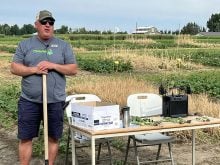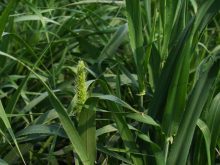A new research project suggests prairie producers who apply pod sealants to their canola should save their time and money and look for other ways to reduce shattering losses.
Chris Holzapfel, a researcher with the Indian Head Agricultural Research Foundation (IHARF), told growers at Crop Production Week held in Saskatoon from Jan. 9-16 that a new study suggests there are no benefits to using pod sealant products on canola crops that are straight combined.
Instead, producers who choose to straight combine their canola should time their harvest operations carefully and choose varieties with proven shatter resistance.
Read Also

AI expected to make itself felt in food systems
Artificial intelligence is already transforming the food we eat, how farmers produce it and how it reaches the consumer, experts say
The study also suggests that straight combining is still a viable option, even on crops that have not been treated.
In the study, yields from crops that were straight combined were consistently as high or higher than yields from crops that were swathed and harvested with a pick-up header.
“No evidence in our study warrants recommending pod sealants to reduce the risks of straight combining,” Holzapfel told farmers.
“Growers should not be discouraged from straight combining canola but (they should remember that) pod sealants add extra expense to harvest operations relative to straight cutting without a sealant.”
The research foundation’s 2009 study clarifies a question that has perplexed canola producers: is straight combining canola a viable option and if so, should pod sealants be applied?
The research supports what many farmers suspected: straight combining is less expensive than swathing and can result in higher yields and higher per acre profits.
However, Holzapfel warned that straight combining canola is more risky than swathing.
Standing canola is more prone to shattering losses and the window for ensuring optimal yields is smaller.
As a result, producers should not attempt to straight cut all of their canola, Holzapfel said.
Instead, they should identify a manageable number of acres that are well suited to straight combining and swath the rest.
The study also casts doubt on the notion that pod sealants are a beneficial investment.
Pod sealant products have been on the market in Canada for at least two years.
Per acre costs vary depending on the method of application but the products themselves cost about $10 an acre when applied at the recommended rate.
The IHARF study assumed an application cost of $4 per acre for total investment of $14 per acre.
Application costs would probably be higher if the product was applied by a custom or aerial applicator, Holzapfel said.
Assuming a canola price of $9.07 per bushel, a producer would have to harvest an extra bushel and a half per acre to break even on his $14 per acre investment.
The IHARF study did not account for yield losses associated with tire tracks and trampling.
Although the IHARF study based its findings on a single year of research data, Holzapfel said it offers valuable insight into the feasibility of straight combining canola, with or without pod sealants.
He said yields and growing conditions were widely variable from site to site, but the research evaluated the overall performance of popular pod sealants under field conditions and determined that their ability to reduce shattering losses, increase grain yields and boost financial returns was negligible.
In the study, researchers planted 240 canola plots in Saskatchewan at Indian Head, Scott, Melfort and Swift Current.
At each location, researchers planted five canola varieties and seeded 12 plots of each variety for a total of 60 plots per location.
The study tested varieties 5440, 4362, 45H26, 5020, and Xceed 8571, a juncea canola touted for offering drought and shatter resistance.
At each location, plots received identical seeding treatments.
At harvest, four harvest treatments were used: swathing with no pod sealant applied, straight combining with no pod sealant applied, straight combining with Brett Young’s Pod Ceal DC applied pre-harvest and straight combining with United Agri-Products Pod Stik applied pre harvest.
At all locations, straight combining 5440 offered the highest yield and the highest per acre returns, followed by 45H26, 5020, 4362 and Xceed 8571.
Xceed 8571, a Viterra variety, is touted for offering outstanding shatter resistance, which makes it ideally suited to straight combining.
However, it was the lowest yielding variety at all sites in the study, averaging 26.1 bu. per acre across 60 plots.
By comparison, Invigor 5440 averaged 44.6 bu. per acre across all sites, followed by 45H26 RR (41.4 bu.), 5020 (36.9 bu.) and 4362 LL (33.2 bu.).
The experiment also determined that shatter-related losses varied from variety to variety and site to site, but losses were consistently lower in Invigor 5440.
Holzapfel said IHARF is hoping to conduct similar research in 2010, pending approval of additional funding.
Funding and support for the project came from the Saskatchewan Canola Development Commission, Agriculture Canada, Western Applied Research Corporation, the Northeast Agricultural Research Foundation and the Wheatland Conservation Area.
















